If you want to grab the recruiter’s attention right off the bat, you need to create a stellar work experience resume section. This is one of the best indicators of how good you are at what you do.
A work experience section is meant to be the centerpiece of a resume. While your skills and education do describe you and talk about your potential value, work experience lets the recruiters know you can truly bring to the table.
Interested in learning how to effectively add these essential pieces of information on your resume? Keep reading, as our guide contains everything you need to know on this topic!
Key Takeaways
Be brief when listing your work experience. Put the accurate title, company name, employment start and end dates (a month and a year).
Make the work experience part a separate section, but use the same formatting rules as in the rest of the resume.
List your professional achievements in chronological order and use bullet points with action verbs to emphasize important parts.
Tailor your work experience section to match the job requirements by listing the skills and work history details that are relevant to the position you’re applying for.
Highlight promotions and don’t try to hide the employment gaps.
Why is Listing Work Experience on Your Resume Important
Having work experience on a resume is crucial. This section directly shows recruiters what they can expect from you, and it’s the first thing they look forwhen reviewing your resume.
Listing your skills and education is important, but it’s through work history that you quantify and emphasize your credentials. There’s no better way to do it than by displaying notable professional results you achieved in your previous roles.
The more work experience you have, the less you need to talk about other qualifications. By making this part of your resume stand out, you indirectly add value to other parts of your resume. That’s why you want to make sure your work experience resume section is spotless.
What Information Goes in the Work Experience Section on a Resume?

Given that the work experience resume section is such an important one, you should aim to make it impeccable. To make this easier to achieve, we’ve compiled a list of essential guidelines to help you create this part of your resume with minimal hassle.
Job Title
When adding a job title to your resume, you must be concise. Put the accurate title in the description, but don’t try to get too creative with it. Terms like “marketing wizard” or “SEO magician” might not be the right kind of catchy.
For starters, your resume must be professional and emit a serious tone. Also, there’s the fact that both recruiters and ATS look for keywords when skimming resumes. Fancy words that you might use to describe your job title could detract from the necessary information. They can also cast a shadow on important keywords relevant to the job you’re applying for.
Company Name & Location
When talking about the companies you used to work for and their locations, don’t go into too much detail.
More often than not, one line is enough to get your point across. State the company’s name and the location you used to work at. There’s no need to thoroughly explain how that company operates, as this information is redundant and draws attention away from key points.
Once the recruiter gets interested, they might look into your former employers on their own or ask you questions during interviews to learn more about your professional background.
Employment Dates
When listing employment dates, the key is to be consistent. Always use the same format. Don’t use “Sept 2011–Oct 2015” for one job and “10/2015–05/2018” for the next.
Also, to keep the section succinct and professional, there’s no need to mention exact dates. Months and years will be enough. Finally, if you are currently working at a particular position you listed on your resume, put “present” instead of the end date.
Achievements
Listing professional achievements is a great way to create a captivating work experience resume section. These add substance to your work experience section and showcase that you didn’t merely do your job but also excelled at it.
Using numbers is another way to make your accomplishments even more impressive. Being specific and quantifying your professional achievements with exact numbers can make this section highly effective.
For example, instead of saying how you “led a successful marketing campaign,” explain that you "increased the conversion rate by 25%.” You can see how the second example carries a lot more weight, right?
How to Format the Work Experience Section in Your Resume

The work experience format is just as important as the content in it. Proper formatting is what makes all that crucial information stand out and be clearly visible. Because of that, you should consider the following guidelines when creating a work experience section on your resume.
Work Experience Section Formatting Tips
Make a Separate Section
Every section of your resume must be distinct and clearly visible. This way, even if the recruiter spends just a few seconds skimming through your resume, they’ll know where to find the information they are looking for.
Proper formatting creates a professional resume that’s also pleasant to look at. This also increases your chances of impressing hiring managers and making them spend more time reading your resume.
One of the best and most common placements for your work experience section is right below the resume summary. That way, it will be the first thing recruiters will see after skimming through the introduction.
Since work experience is usually the fundamental part of a resume, placing it near the top of the page is an optimal choice, as you want to create a hierarchy of information. Give recruiters what they want immediately, and they will be more inclined to go through the rest of your resume.
Use Chronological Order
Speaking of hierarchy and order, always make sure that your work experience is listed in chronological order. Start with your most recent job, and then list all the previous workplaces and positions you held.
This approach is ideal, as it makes it easy for recruiters to see your development throughout your professional career. By going through your work experience chronologically, they can see how you improved and grew. That way, they can better understand what to expect from you in the future and whether you can be a valuable, long-term member of their company.
Use Bullet Points
Bullet points are the best work experience format for a resume. They look neat and professional and get the point across in the most efficient way possible. That’s why, in addition to work experience, most of your resume should be in bullet points as well.
They also provide distilled information that is easy to read. When you have a block of text, the recruiters need much more focus and attention to go through it and find the important bits. Plus, you have to use more words to keep the flow of text going.
Bullet points are a staple in resume-making. Even if the recruiters only look at your resume for a few seconds, these will make it easy for them to see the crucial parts, including your work history.
Use the Same Formatting Throughout Your Resume
Another key aspect of resume-building is consistency. Your must be uniform and look the same across all sections. That’s how you make sure that everything looks neat and professional and that recruiters have a pleasant time reading your resume.
Do not change the font style between sections. The work experience part should have the same text size, spacing, and line weight as the rest of your resume. Also, don’t use different colors to visually separate parts of the document unless you’re really proficient in design and you know what you’re doing.
By having consistent formatting, you control which parts of your resume should be emphasized. It’s up to you to include features like bullet points, bolding, and italicizing to draw the recruiter’s attention to your skill proficiency and achievements. Plus, proper formatting helps you pass the ATS.
Use Action Verbs
Action verbs are powerful, highly impactful words that stand out from the rest. When used along with suitable formatting options, they make your work experience section easy to remember.
However, note that people often use all the same action verbs on their resumes. So, choosing unique ones and implementing them in a smart and creative manner is the most secure way to make your resume stand out from the rest.
The next time you’re talking about your leadership skills, for example, instead of saying how you led or managed a team, explain that you empowered them and fostered a productive working environment.
How to Fill in the Work Experience Section Based on Different Levels of Experience

A rich work experience section in a resume is impressive, but it needs to be related to the position you’re applying for. Be mindful when listing your previous jobs—several months of bartending work isn’t relevant if you’re applying for the position of a front-end developer.
Let’s see what your work experience section should look like if you’re a(n):
Student/persone with no work experience
Entry-level candidate
Junior to mid-level candidate
Senior-level candidate
Student/No Experience
If you are a student or someone with little to no experience, that doesn’t mean you can’t have a proper work section. The rules of resume-making are much more lenient when you’re applying for your first job because the recruiters don’t expect you to have years of work history.
The work experience for students should focus on internships, projects, volunteer work, and so on. Think of college assignments that tested your creativity, leadership skills, communication skills, time management, etc. If you did some unpaid work or helped with certain projects, see how that relates to the position you’re applying for and describe it in your resume.
Keep in mind that the same formatting rules apply regardless of your proficiency level and work history. You should use bullet points to make this section clean and readable. Also, don’t forget about bolding, italicizing, and action verbs, which will make even a student’s resume remarkable.
Entry-Level
If you’re applying to an entry-level position, you’re probably in the same situation as most people with no experience. In such cases,it’s acceptable to mention any relevant university and side projects, volunteer work, and part-time work you have done in the past.
Still, you probably have more to put in your work history section than a student. If you did an internship at another company, make sure to point out the results you achieved and the experience you’ve obtained.
On the other hand, if you’re changing careers or getting an entry-level position in a different line of business, you should highlight the accomplishments you’ve previously achieved. Through work history, show your knowledge and abilities that can help you perform in a new position if you become a part of their team.
Junior to Mid-Level
Applying to a junior or mid-level position means you already have a moderate work history. In fact, mid-level employees can have years of experience under their belts. This is when it becomes important to focus on relevance.
As someone who may have changed several jobs or lines of work, you need to keep the position you’re applying for in mind when creating a work experience section. For example, if you worked as a waiter for a few months ten years ago, that might not be important if you’re in the tech field now.
More than that, putting obsolete content in your resume detracts from the important information. Plus, it could mean that you lack industry-specific experience and use irrelevant information as a filler. Therefore, it’s essential to keep the work experience resume section concise and relevant.
Senior Level
Work experience for professionals is vastly different than that of students or entry-level applicants. The recruiters know that seniors have years or even decades of work history under their belts. Here, relevance is more important than ever, and quality is much more valuable than quantity.
When applying for a senior-level job, you should highlight your work-related accomplishments throughout your long career.
Don’t just list previous jobs—point out the results you achieved while you worked in specific positions. Demonstrate how your abilities and knowledge helped you overcome obstacles, accomplish goals, and exceed the expectations of your previous employers.
Utilize a combination resume layout to best showcase your abilities and accomplishments. Don’t go more than 15 years into the past when listing relevant work experience. There’s no point in talking about your internship and entry-level jobs when you’re a highly specialized professional who should be an authority in the field.
How to Tailor Your Work Experience to Match the Job Requirements

Before inserting your work experience into your resume along with all your skills and achievements, you should research the job posting and the company. The goal is to adapt your work experience to match the positionyou’re applying for.
Even if you have a long and impressive work history and a sizable list of skills, some of these might not be useful to the recruiter and the company you want to work for. Keep in mind that the difference between relevant and irrelevant skills and achievements isn’t always clear-cut. That’s particularly true for soft skills, which are highly transferable and usable across various industries.
For example, say you’re a designer who wants to transition to a managerial position. You should highlight your achievements that involve problem-solving, creativity, communication, teamwork, and time management. On the other hand, there’s no need to talk about your experience with Figma or Sketch too extensively, as they have nothing to do with being a manager.
7 Extra Tips to Perfect Work Experience on Your Resume
Now that we’ve covered the basic and most important guidelines, here are 7 bonus tips to help you perfect that work experience resume section!
Tip #1. Spell-Check Your Resume
Proper spelling is essential. A misspelled word might seem like a minor issue, but it draws the wrong kind of attention. It looks unprofessional and makes you look like someone that lacks attention to detail. Also, ATS might not be able to read a misspelled job title, so your resume might not even reach the recruiters.
Besides the information on your resume, the way it looks and how it's put together also says a lot about you. Therefore, you should bring your commitment and dedication to perfection by ensuring everything is flawless.
Make sure to thoroughly proofread your resume before sending it by running it through Grammarly or any similar program. If you want to double-check everything, you can also ask a friend to help you out by revising your resume once again.
Tip #2. Don’t Hide Gaps in Your Resume
Even though some employees see them as intimidating, resume gaps are nothing to fear. They are perfectly normal, and there are several ways to make the best of them when listing work experience on a resume.
Don’t try to hide the gaps because employers will find them. Omitting months when creating a resume and only writing years is not the way to go. Instead, show the gap and explain in a sentence or two what caused it, but be honest.
Alternatively, use a functional or hybrid resume layout instead of a chronological one. They focus on showing your work history, skills, and abilities without a precise timeline.
Tip #3. List Relevant Promotions
Promotions are a great way to highlight your work proficiency and expertise. They show you as a trustworthy, committed, and valuable employee, which is why you want to list them whenever possible.
If you’ve been promoted within the same company, you can save resume space and only mention the company once. Then, list the responsibilities you were tasked with or positions you were promoted to in reverse-chronological order.
Yet, if you've been switching companies while getting promoted, make sure to list each one as a separate entry to further underline your value and skills.
Tip #4. Mind the Length of Your Resume
Most resumes should be one page long. As a result, you should be mindful of the information you put in. When listing your work history, you want to include as much important and relevant information as possible, while being brief and specific.
Don’t go into too much detail talking about every single project and achievement. Instead, mention the most important ones that will interest the recruiter the most.
Using bullet points will help you remain short and to the point. Combine this with power words, bolding, and italicizing to make a succinct but powerful work experience resume section.
Tip #5. Add Important Soft and Hard Skills
Skills are tightly related to your work experience, and there are two types of them.
Hard skills are specialized and industry-specific, and they enable you to do your job. They are also quantifiable and often easily measured.
Soft skills are broader than hard skills. They are applicable to any profession and, as a result, highly transferable. They also describe the interpersonal attributes that make you more productive, better at communicating and working with others, etc.
When listing these skills in your resume, keep in mind that recruiters will be interested in your hard skills first. List them at the very beginning of the section, and then follow up with a strong collection of soft skills. Use only the skills that are relevant to the position you’re applying for, and keep strong and soft skills separate.
Tip #6. Mention Significant Courses
A strong work experience section on a resume can only get better if you add relevant courses and additional qualifications to it. If you’ve attended certain courses that gave you applicable skills and made you a more valuable employee, make sure to include them in your resume.
Even then, it’s essential to stay on topic and only list those additional skills and courses that are relevant to the job posting.
Tip #7. Make Use of Additional Resume Sections
Sometimes, you might have even more to add to your work experience—for example, some certifications applicable to the position or a driver's license. This, as well as mentioning memberships in particular groups or clubs, can also significantly enrich your resume.
Examples of Work Experience on Resume
There are many rules and guidelines that can help you create the perfect work experience resume section. To assist you with this, we’ve prepared several examples that feature good and bad practices. Let’s start with the good one:
Good Example
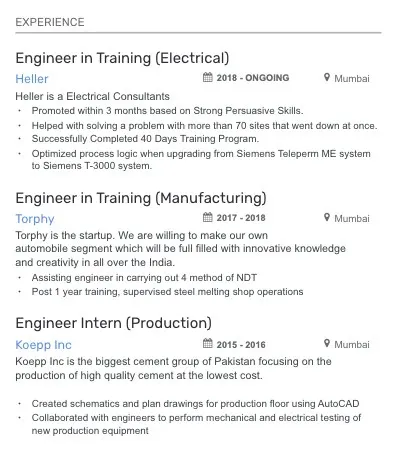
This reverse-chronological work experience section has everything. From the relevant information to suitable formatting and presentation, everything looks clean, readable, and professional. Pay attention to the use of bullet points, power words, and highlighted promotions—all these details are present and add value to the resume.
Here’s another good example of a student’s resume with little prior work experience:
Another Good Example
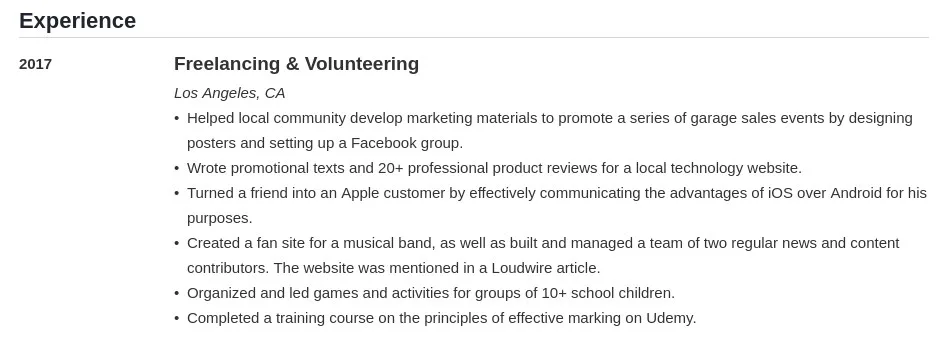
Concise wording and the use of bullet points while listing relevant projects and activities make for a professional-looking experience section.
Now, let’s take a look at one bad example:
Bad Example
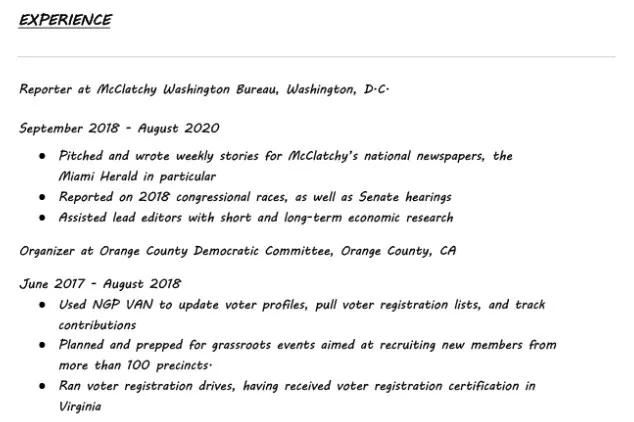
The first thing you’ll notice while looking at this work experience section is the poorly legible font. The content could be impressive, but most recruiters wouldn’t bother reading a single word, and there could also be problems with ATS readability due to this.
Here’s another example of how not to create a work experience resume section:
Another Bad Example
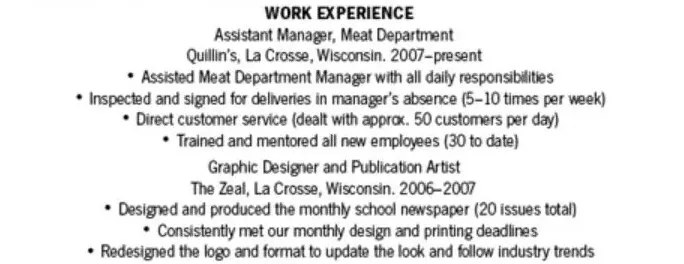
While the font choice is acceptable this time, the poor formatting makes a whole section hard to read. The central alignment is often not the best choice. Better line spacing and font sizing could help create a hierarchy and separate distinct parts more effectively.
3 Job-Winning Resume Examples
To help you better understand how to format a resume and how the work experience section fits in with the rest of the document, we’ve prepared five job-winning resume examples.
#1 Resume Example

#2 Resume Example

#3 Resume Example
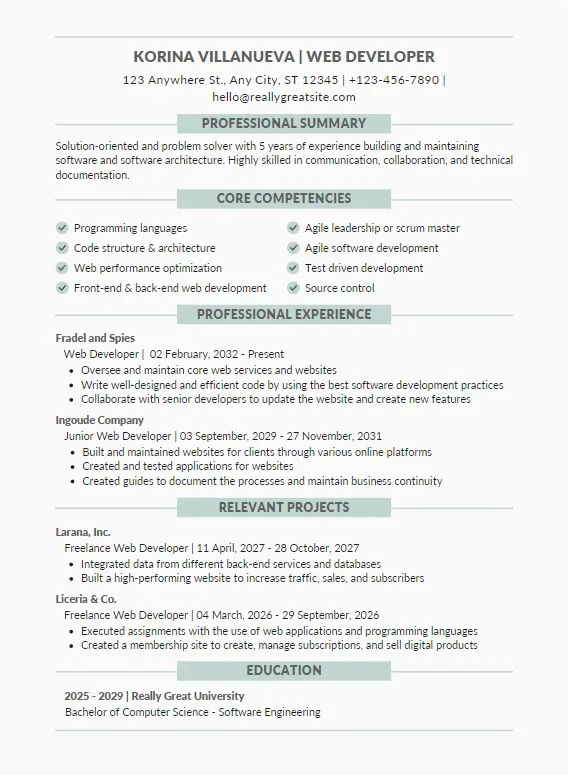
This is an example of a well-balanced resume that doesn’t elevate one section above the rest. After a summary and core hard skills, you get a brief and to-the-point professional experience section. The combination of different font sizes and weights with the use of bullet points makes for a minimalist but effective document with a memorable work experience resume part.
Closing Thoughts
Work experience is the backbone of your resume. It is the strongest indicator of your ability to do the job and bring prosperity to a potential employer. Recruiters spend most of their time reading this section, so you want to make sure it’s impeccably written and formatted.
We hope that our list of guidelines, tips, and tricks will help you create the perfect resume. Ensure you check it out whenever you need a reminder, and you’ll land that dream job in no time!


